Sapphire or Tanzanite? Choosing between these stunning blue gemstones depends on durability, rarity, and brilliance. While Sapphire boasts centuries of prestige and toughness, Tanzanite captivates with its rare color-shifting beauty. Discover their key differences to find the perfect gemstone for your jewelry or investment.
Color Change Sapphire Halo Cocktail Ring in 18k White Gold |
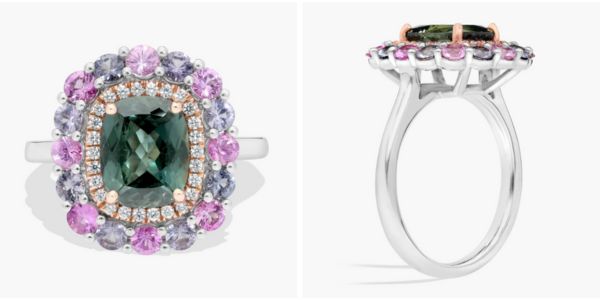
|
| Experience the Magic – Click to Shop Now! |
Table Of Contents
- 1) Understanding Sapphire and Tanzanite Gemstones
- 1.a) Origins and Discovery.
- 1.b) Geological Formation and Composition.
- 1.c) Color Variations and Causes.
- 1.d) Global Mining Locations of Sapphire and Tanzanite Gemstone.
- 2) Physical and Optical Properties Of The Two Gemstones
- 2.a) Hardness and Durability.
- 2.b) Clarity and Transparency.
- 2.c) Luster and Light Reflection.
- 2.d) Refractive Indices and Light Dispersion.
- 3) Market Value and Rarity
- 3.a) Availability and Scarcity.
- 3.b) Pricing Factors of Tanzanite and Blue Sapphire.
- 3.c) Investment Potential.
- 4) Jewelry Applications
- 5) Cultural Significance and Symbolism
- 5.a) Historical Beliefs and Myths.
- 5.b) Birthstones and Anniversaries.
- 5.c) Tanzanite vs Sapphire Symbolic Meanings.
- 6) Sapphire vs. Tanzanite Comparison Table: Key Differences Explained
- 7) Conclusion
|
|
1) Understanding Sapphire and Tanzanite GemstonesBack To Top |
Both gems have distinct chemical structures and optical properties, making them unique in their own right. Understanding their history, formation, and attributes can help you decide which suits your needs best.
|
|
1.a) Origins and Discovery.Back To Top |
Sapphire and Tanzanite have distinct origins, with one boasting an ancient legacy and the other being a rare modern find. Sapphires have been mined for thousands of years, while Tanzanite was only discovered in the 20th century. Their geological formation, historical significance, and market introduction set them apart as two of the most fascinating blue gemstones.
The Rich History of Sapphire
Sapphires have been cherished for thousands of years, symbolizing wisdom, protection, and divine favor in many cultures. Ancient civilizations, including the Greeks, Persians, and Romans, adorned royalty with these gemstones, believing they held mystical powers.
Oval Sapphire and Diamond Double Halo Micropavé Ring in 18k White Gold |
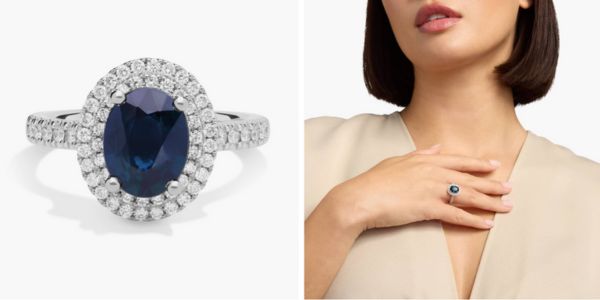
|
| Click on the Image |
The earliest sapphires were mined in Sri Lanka, India, and Myanmar, regions that still produce some of the finest specimens today. Over time, deposits in Australia, Madagascar, and Thailand expanded the supply, cementing sapphire’s place in high-end jewelry.
The Recent Emergence of Tanzanite
Unlike sapphire, Tanzanite is a modern discovery that surfaced in 1967 near Mount Kilimanjaro in Tanzania. This rare tanzanite natural rock was found by Maasai tribesmen, who initially mistook it for sapphire due to its deep blue hue.
Originally, the gemstone was called Blue Zoisite, but the jewelry industry feared the name sounded too much like “blue suicide,” making it unappealing for sales. To market it more effectively, it was named after its country of origin, Tanzania, giving it the now-famous name, Tanzanite.
Tiffany & Co. quickly recognized Tanzanite’s commercial potential and introduced it to the global market. Because it’s mined in just one location on Earth, its availability is limited, making it highly prized by collectors and jewelry lovers.
|
|
1.b) Geological Formation and Composition.Back To Top |
Sapphire and Tanzanite have distinct chemical compositions, influencing their durability, color, and formation process. Sapphires, made of aluminum oxide, form deep within the Earth’s crust under intense heat and pressure, while Tanzanite, a type of zoisite, develops through rare volcanic activity in Tanzania. These differences give each gemstone its unique structural properties and color variations.
Sapphire’s Corundum Structure
Sapphires belong to the corundum mineral family, composed primarily of aluminum oxide. Trace elements like iron and titanium create their striking blue color, while chromium produces rarer pink and red variations.
Formed under extreme heat and pressure deep within the Earth’s crust, sapphires take millions of years to develop. Their durability, ranking 9 on the Mohs scale, makes them second only to diamonds in hardness, ensuring long-lasting wear in fine jewelry.
Tanzanite’s Zoisite Mineralogy
Tanzanite is a variety of the mineral zoisite, composed of calcium, aluminum, and silicate. Unlike sapphire, it forms in a single, localized geological setting due to unique volcanic activity beneath Tanzania’s surface.
14K White Gold Round Halo Tanzanite and Diamond Earrings |
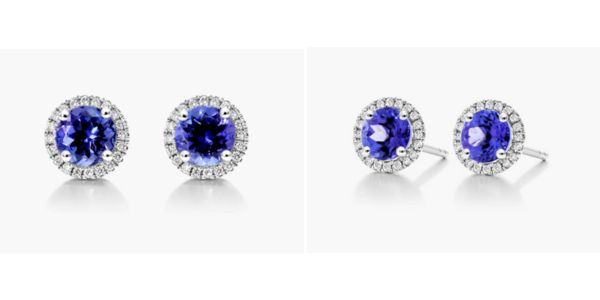
|
| Discover Elegance – Click to Shop Now! |
Its stunning blue-violet hues come from traces of vanadium, activated through natural or heat treatment. With a Mohs hardness of 6 to 7, Tanzanite is softer than sapphire, requiring extra care to prevent scratches and damage.
|
|
1.c) Color Variations and Causes.Back To Top |
Tanzanite vs sapphire color
The striking colors of Sapphire and Tanzanite result from unique mineral compositions and light interactions. Sapphires display a broad spectrum of blue shades, influenced by iron and titanium, while Tanzanite’s pleochroic nature allows it to shift between blue, violet, and purple. Heat treatments enhance both gemstones, maximizing their brilliance and market appeal.
The Spectrum of Sapphire Hues
Sapphires come in an array of blue tones, from soft sky blue to deep royal blue, depending on the concentration of iron and titanium. The most coveted shade is cornflower blue, particularly those from Kashmir, renowned for their velvety appearance.
Heat treatment enhances color uniformity, improving clarity and vibrancy. Although blue is the most popular, sapphires exist in pink, yellow, green, and even color-changing varieties, offering endless design possibilities.
Tanzanite’s Unique Pleochroism
Tanzanite displays pleochroism, meaning it shifts between beautiful blue, violet, and purple depending on the light source and angle. This effect gives the gem an ever-changing brilliance, making it visually dynamic in jewelry.
Natural Tanzanite typically appears brownish due to mineral impurities. Heat treatment reveals its signature blue-violet shades, enhancing its appeal without altering its structure. Unlike sapphire, Tanzanite’s color intensity depends on viewing direction, adding to its mystique.
14K White Gold Drop Oval Halo Tanzanite and Diamond Earrings (7x5mm) |
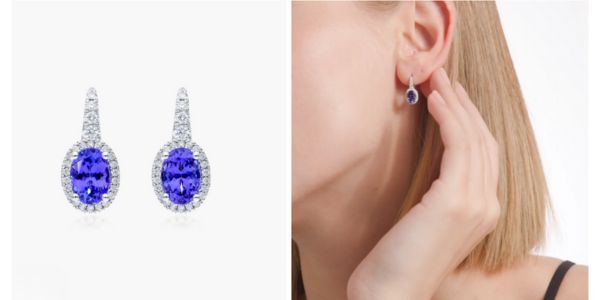
|
| Elevate Your Style – Tap The Image to Explore! |
|
|
1.d) Global Mining Locations of Sapphire and Tanzanite Gemstone.Back To Top |
Sapphire and Tanzanite originate from vastly different mining regions, impacting their availability and market value. Sapphires are found in multiple countries, each producing gems with distinct hues and qualities, while Tanzanite comes from a single source in Tanzania. This contrast in geographic distribution makes Tanzanite significantly rarer and more exclusive than Sapphire.
Sapphire Deposits Worldwide
Sapphire mining occurs across Sri Lanka, Myanmar, Australia, Thailand, Madagascar, and Montana (USA). Each region produces gems with unique characteristics—Sri Lankan sapphires often feature vibrant blues, while Australian varieties lean toward deeper inky tones.
The most famous mines, such as Myanmar’s Mogok Valley, yield top-tier sapphires prized for their exceptional clarity and saturation. Ethical sourcing has become a growing concern, with sustainable mining efforts gaining traction in various regions.
Tanzanite’s Exclusive Tanzanian Source
Tanzanite is mined exclusively in the Merelani Hills of Tanzania, making it one of the rarest gemstones on Earth. The deposit spans just a few square miles, meaning future supplies are finite and highly dependent on continued extraction.
14K White Gold East West Set Oval Halo Tanzanite and Diamond Necklace (7x5mm) |
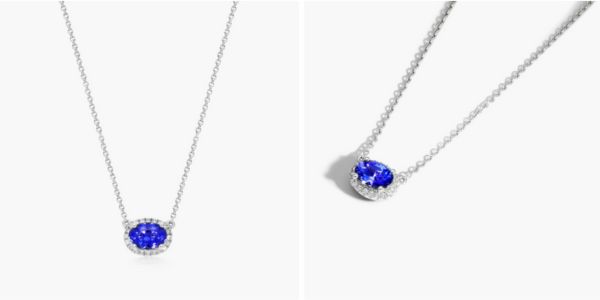
|
| Grace Your Look – Click On The Image to Shop Now! |
Strict government regulations control Tanzanite mining, ensuring ethical labor practices and controlled distribution. Due to its single-source rarity, many collectors see Tanzanite as a unique investment opportunity, distinct from widely available gemstones.
|
|
2) Physical and Optical Properties Of The Two GemstonesBack To Top |
Sapphire and Tanzanite each have unique physical and optical characteristics that influence their beauty, durability, and value. Their differences in hardness, clarity, luster, and light dispersion make them suited for different types of jewelry.
A thorough comparison of these properties helps in selecting the right gemstone, especially for engagement rings, heirloom pieces, and investment jewelry.
|
|
2.a) Hardness and DurabilityBack To Top |
Sapphire and tanzanite have unique characteristics that appeal to different tastes in gemstone jewelry. vastly different hardness levels, affecting their resistance to scratches and daily wear. While sapphire ranks high in durability, Tanzanite requires extra care to maintain its brilliance.
Understanding their structural strength and fracture resistance is crucial when choosing jewelry, especially for rings, bracelets, and everyday accessories.
Sapphire’s Superior Hardness
Sapphire is one of the hardest natural gemstones, ranking 9 on the Mohs scale. Its exceptional hardness makes it highly resistant to scratches, making it ideal for daily wear and heirloom jewelry.
Oval Sapphire and Diamond Halo Split Shank Ring in 18k White Gold |
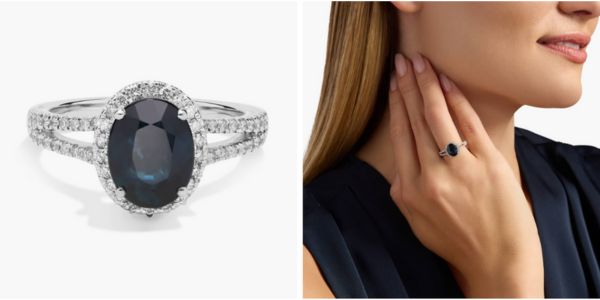
|
| Timeless Elegance Awaits – Click On The Image To Shop! |
This strength comes from its dense atomic structure, formed under immense heat and pressure over millions of years. Because of this, sapphires and tanzanite jewelry are often used in gemstone collections. Unlike softer stones, they rarely require protective settings, offering more design flexibility.
Tanzanite’s Relative Softness
Tanzanite ranks 6 to 7 on the Mohs scale, making it significantly softer than sapphire. Its structure is more prone to scratches, chips, and fractures, requiring extra caution when worn daily.
Jewelry settings for Tanzanite often include protective bezels or prongs to shield the stone from damage. While stunning in rings and pendants, Tanzanite is better suited for occasional wear or carefully maintained pieces to preserve its brilliance over time.
|
|
2.b) Clarity and TransparencyBack To Top |
The clarity of a gemstone affects its brilliance, value, and overall visual appeal. Sapphire and Tanzanite display distinct differences in their inclusions, with one often requiring enhancement treatments.
Understanding their natural clarity and common flaws helps in choosing the best quality gem for long-term enjoyment.
Evaluating Inclusions in Sapphires
Sapphires naturally contain inclusions, often in the form of needle-like rutile, known as silk, or fingerprint-like veils. While these inclusions may lower clarity, they help gemologists distinguish natural sapphires from synthetic counterparts.
Sapphire and Diamond Three Stone Ring in 14k White Gold |
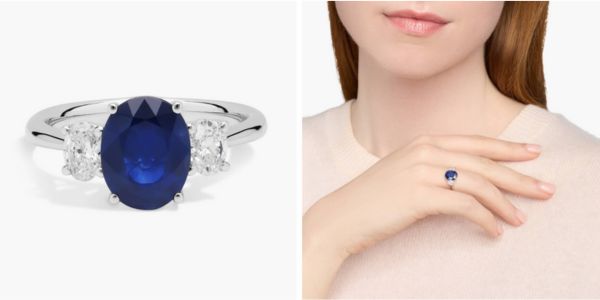
|
| Radiate Sophistication – Tap On The Image to Explore! |
Higher-quality sapphires have minimal visible inclusions, especially in lighter shades. Heat treatment is commonly used to reduce imperfections and enhance transparency, making the stone more visually appealing without affecting its durability.
Tanzanite’s Typically High Clarity
Tanzanite is often found with shades of blue that are unlike any other gemstone. It displays excellent clarity, with fewer visible inclusions compared to sapphire. Most high-grade Tanzanite gems appear eye-clean, meaning imperfections are not visible without magnification.
Due to its geological formation, Tanzanite rarely needs clarity treatments. This natural transparency enhances its pleochroic color shifts, allowing it to display deep shades of blue, violets, and purples under different lighting conditions.
|
|
2.c) Luster and Light ReflectionBack To Top |
Luster defines how a gemstone interacts with light, influencing its shine, brilliance, and overall attractiveness. While both stones exhibit stunning reflections, their unique compositions create different visual effects.
Choosing between Sapphire and Tanzanite depends on personal taste, setting style, and how much brilliance you prefer in a gemstone.
Sapphire’s Brilliant Luster
Sapphires display a highly reflective luster, creating a bright, almost metallic glow under direct light. This effect is due to its dense crystalline structure, which efficiently bounces light back to the viewer’s eye.
Polished sapphires exhibit a glassy-to-adamantine shine, making them stand out even in dim lighting. Their natural brilliance, combined with deep blue hues, makes them a favorite for high-end rings, necklaces, and statement pieces.
Tanzanite’s Vitreous Sheen
Tanzanite possesses a vitreous (glass-like) luster, giving it a softer yet more luminous glow. Its pleochroic nature allows it to shift between deep blue, violet, and purple, creating a mesmerizing play of colors.
This light interaction makes Tanzanite appear highly radiant in well-cut designs, especially in oval, trillion, and cushion cuts. However, due to its slightly softer composition, polishing and maintenance are essential to keep its surface flawless.
|
|
2.d) Refractive Indices and Light DispersionBack To Top |
Light performance plays a huge role in how a gemstone sparkles. The refractive index measures how much light bends when entering a gem, while dispersion refers to the rainbow-like flashes of color that appear in well-cut stones.
Both Sapphire and Tanzanite exhibit distinct optical properties, influencing their brilliance and fire.
Sapphire’s Optical Performance
Sapphire has a high refractive index (1.76 – 1.78), meaning it bends and reflects light efficiently, creating strong brilliance. However, its dispersion is relatively low, meaning it does not produce as many rainbow-like flashes as diamonds.
Five Stone Oval Sapphire and Diamond Halo Anniversary Ring in 14k White Gold |
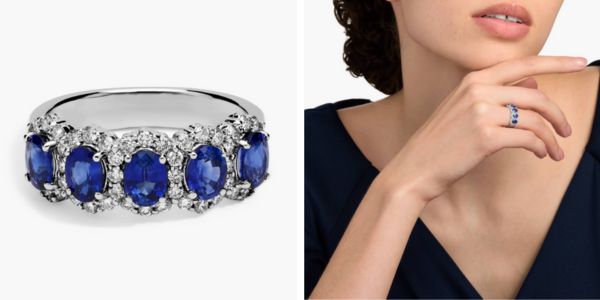
|
| Celebrate Forever – Click On The Image To Shop Now! |
Its deep, rich color and intense sparkle come from its dense structure and precise faceting. Well-cut sapphires display excellent contrast between dark and light areas, making them visually striking in sunlight or artificial lighting.
Tanzanite’s Light Interaction
Tanzanite has a refractive index of 1.69 – 1.70, slightly lower than sapphire, meaning its sparkle is more subtle. However, its pleochroic effect enhances its beauty, allowing it to shift between blue, violet, and purple depending on the viewing angle.
This effect gives Tanzanite a unique, almost magical glow that changes under different lighting conditions. Its light dispersion is slightly higher than sapphire’s, giving it a faint but noticeable rainbow-like fire, especially in well-faceted stones.
|
|
3) Market Value and RarityBack To Top |
Sapphire and Tanzanite differ significantly in availability, pricing, and long-term investment potential. One is a historically treasured gemstone with an established market, while the other is a newer, highly limited discovery.
Understanding their market demand, pricing trends, and investment viability can help collectors and buyers make informed choices.
|
|
3.a) Availability and ScarcityBack To Top |
Sapphire is found in multiple locations worldwide, ensuring a steady supply for the global market. However, premium-quality stones from renowned sources are rare and command high prices.
Tanzanite, on the other hand, is mined from a single deposit in Tanzania, making it far rarer. As supply depletes, prices are expected to rise, making it an attractive option for collectors.
Sapphire’s Global Presence
Sapphires are sourced from Sri Lanka, Myanmar, Australia, Madagascar, and Thailand, among other countries. These diverse mining locations ensure a consistent supply, though fine-quality stones remain difficult to find.
Certain sources, like Kashmir, produce legendary sapphires with deep blue hues and velvety textures, making them highly sought after. Despite a broad geographical spread, market demand for blue sapphire and tanzanite continues to rise.
Tanzanite’s Limited Supply
Tanzanite is mined exclusively in the Merelani Hills of Tanzania, covering a small geographical area. This single-source dependency makes it far rarer than sapphire, increasing its long-term value potential.
With limited reserves and strict mining regulations, Tanzanite’s availability is expected to diminish over time. As supplies decrease, demand from investors and jewelry enthusiasts continues to grow, making it a gemstone with a unique market position.
|
|
3.b) Pricing Factors of Tanzanite and Blue SapphireBack To Top |
Tanzanite Vs Sapphire Cost
To put it very simply price per carat of Sapphires is higher, especially for deep blue untreated stones. And price per carat of Tanzanite is comparitively lower but increasing due to limited supply and high demand
Sapphire pricing depends on color intensity, clarity, origin, and treatment history. Unheated, richly colored stones command premium rates, while lighter or treated varieties are more affordable.
Blue Sapphire and Emerald Ring with Diamond Details in 18k White Gold |
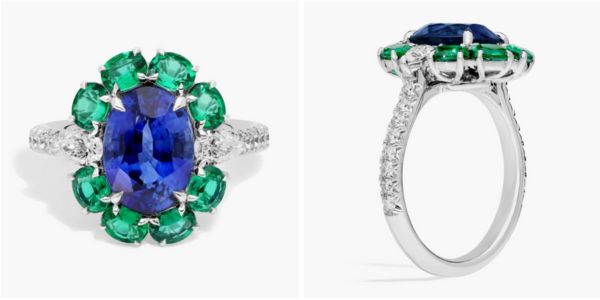
|
| Bold Luxury Awaits – Tap On The Image to Explore! |
Tanzanite’s price is heavily influenced by carat weight, depth of blue, and market speculation. As a newer gem, its valuation is less predictable but trending upward due to scarcity.
The Impact of Color and Clarity on Sapphire Prices
Deep, vivid blue sapphires fetch the highest prices, particularly those with royal blue or cornflower blue tones. Stones with lighter or grayish hues are valued lower, as are those with visible inclusions.
Untreated sapphires are far rarer and command premium prices, especially when clarity is high. Heat-treated stones, while still valuable, are more abundant and offer buyers. Many consumers seek budget-friendly options in sapphire jewelry without compromising brilliance.
How Carat Weight Affects Tanzanite Value
Tanzanite’s pricing structure is unique—larger stones display deeper color saturation, making high-carat gems significantly more valuable. Smaller stones often appear lighter in shade and are priced accordingly.
Due to its limited supply and strong global demand, Tanzanite’s per-carat value has steadily increased. High-quality pieces over 5 carats with intense blue-violet hues are particularly prized, offering strong investment potential.
|
|
3.c) Investment PotentialBack To Top |
Sapphires have long been recognized as a stable investment, maintaining high value due to their durability, rarity, and historical significance. Blue sapphires, especially from elite sources, continue to appreciate.
Investing in tanzanite jewelry is considered high-risk, high-reward due to its single-source rarity. If the mines close or output decreases, prices may skyrocket, making it a potential collector’s gem.
Long-Term Value of Sapphires
Sapphires have consistently appreciated in value, making them a secure investment for collectors and traders. Stones from Kashmir, Burma, and Ceylon (Sri Lanka) are particularly sought after, often selling for record-breaking prices.
Because sapphire is durable and widely accepted in the gemstone market, demand remains strong. Whether held as an asset or set in heirloom jewelry, fine sapphires retain their worth over decades, offering both beauty and financial security.
Tanzanite Gemstone as a Collector’s Gem
Tanzanite’s scarcity and single-source dependency make it a fascinating investment choice. Unlike sapphire, its market value is driven by limited availability rather than historical demand.
Collectors who acquire deep blue, high-carat Tanzanite stand to benefit as supplies diminish. However, since it lacks the centuries-old reputation of sapphire, its long-term appreciation remains subject to shifts in market trends.
|
|
4) Jewelry ApplicationsBack To Top |
Sapphire and Tanzanite are widely used in high-end jewelry, offering unique beauty and character. Their striking colors and rarity make them popular choices for rings, necklaces, earrings, and bracelets.
Selecting the right gemstone depends on durability, design preferences, and lifestyle considerations, ensuring that the piece remains stunning over time.
|
|
4.a) Popular Uses in JewelryBack To Top |
Sapphire has been a classic choice in fine jewelry for centuries, known for its deep blue color and exceptional hardness. It is frequently set in engagement rings, heirlooms, and luxury pieces.
Tanzanite, with its vibrant blue-violet hues, has gained popularity in modern jewelry designs, especially in statement rings, pendants, and earrings. Its exclusivity makes it an appealing choice for collectors.
Sapphire in Engagement Rings and Heirlooms
Sapphire has been a favorite for engagement rings and heirloom jewelry for generations. Its durability ensures lifelong wear, making it an excellent alternative to diamonds.
Royalty and celebrities have long favored deep blue sapphires, with iconic pieces like Princess Diana’s engagement ring sparking global demand. Their ability to retain brilliance and value makes them ideal family heirlooms, passed down across generations.
Tanzanite in Modern Jewelry Designs
Tanzanite’s bold blue-violet color and rarity have made it a favorite in contemporary jewelry. Designers often use it in statement rings, artistic pendants, and luxury earrings, where its color-shifting effect adds intrigue.
Because Tanzanite is softer than sapphire, protective settings help maintain its beauty. Its captivating pleochroism, shifting between blue, violet, and purple, makes it a standout in modern, innovative jewelry creations.
|
|
4.b) Care and MaintenanceBack To Top |
Sapphire’s toughness and scratch resistance make it a low-maintenance gemstone, requiring minimal care. Regular cleaning keeps its brilliance intact.
Tanzanite, being softer, demands more careful handling to avoid scratches and fractures. Proper storage and cleaning techniques help maintain its luster.
Preserving Sapphire’s Durability
Sapphires are highly resistant to scratches and everyday wear, making them easy to maintain. However, they can still accumulate dirt and oil, dulling their shine over time.
A simple cleaning routine using warm water, mild soap, and a soft brush restores their brilliance. Avoiding harsh chemicals and ultrasonic cleaners helps preserve their natural beauty. Professional polishing can also enhance their luster if worn frequently.
Special Care Guidelines for Tanzanite
Tanzanite’s softer composition makes it more delicate than sapphire, requiring extra care to prevent damage. Avoiding rough impact, sudden temperature changes, and strong cleaning agents is essential to maintain its structure.
To clean Tanzanite safely, use a gentle soap solution and a soft cloth, avoiding ultrasonic or steam cleaners. Storing it separately from harder gemstones, such as sapphires or diamonds, helps prevent accidental scratches.
|
|
4.c) Design ConsiderationsBack To Top |
Sapphire’s durability allows for a wide range of settings, from solitaire rings to elaborate vintage designs. Its toughness makes it suitable for daily wear in high-contact jewelry like rings and bracelets.
Tanzanite, being softer, benefits from protective settings, such as bezel or halo designs. Choosing the right jewelry structure ensures long-term wearability without compromising its beauty.
Choosing Settings for Sapphire Piece
Sapphires can withstand prong, bezel, and tension settings, giving designers flexibility in crafting elegant, secure pieces. Their toughness allows for intricate cuts, including round, oval, and princess shapes.
Platinum and gold settings enhance sapphire’s rich blue tones, creating timeless designs. Whether used in a classic solitaire or a bold halo setting, sapphire remains one of the most versatile gemstones in jewelry.
Optimal Designs to Protect Tanzanite
Since Tanzanite is more prone to scratches and chipping, choosing the right setting is crucial. Bezel settings provide a protective metal rim, reducing exposure to impact.
Halo designs, where smaller diamonds or sapphires surround the Tanzanite, offer both protection and added brilliance. Placing Tanzanite in pendants and earrings rather than rings also minimizes wear and extends its longevity.
|
|
5) Cultural Significance and SymbolismBack To Top |
Sapphire and Tanzanite have deep cultural and symbolic meanings, influencing their use in jewelry and spiritual practices. While one has been revered for centuries, the other has quickly gained recognition for its unique properties.
Both gemstones are associated with wisdom, transformation, and personal growth, making them powerful choices for meaningful jewelry.
|
|
5.a) Historical Beliefs and MythsBack To Top |
Sapphire has been treasured for thousands of years, believed to offer protection, guidance, and divine favor. It has played a role in royal traditions, religious artifacts, and mystical beliefs across different cultures.
Tanzanite, a relatively recent discovery, has quickly gained cultural significance, especially among the Maasai people of Tanzania. Its association with spiritual awakening and new beginnings continues to grow.
Sapphire in Ancient Lore
Sapphires have been symbols of power, purity, and divine connection since ancient times. Kings, priests, and spiritual leaders wore them as a sign of wisdom and protection.
The Persians believed that the sky was blue because it reflected the color of a giant sapphire beneath the Earth. In medieval Europe, these gems were thought to shield wearers from envy and harm, making them a favorite among royalty.
Tanzanite’s Cultural Emergence
Unlike sapphire, Tanzanite was only discovered in the 1960s, but its cultural impact has been profound. The Maasai people of Tanzania consider it a stone of transformation, often gifting it to newborns and newlyweds as a symbol of prosperity.
Tiffany & Co. played a major role in popularizing Tanzanite worldwide, branding it as a rare and exotic alternative to traditional gemstones. Its unique ability to shift between blue, violet, and purple hues has added to its mystique, making it highly desirable.
|
|
5.b) Birthstones and AnniversariesBack To Top |
Sapphire has long been recognized as the birthstone for September, symbolizing wisdom, loyalty, and protection. It is also associated with fifth and forty-fifth wedding anniversaries, marking significant milestones in relationships.
Tanzanite is the official birthstone for December, representing transformation, spiritual growth, and new beginnings. Its rarity makes it an excellent choice for unique and meaningful gifts.
Sapphire as September’s Birthstone
People born in September are traditionally linked to sapphire, a gem believed to bring clarity of thought and emotional balance. Ancient civilizations considered it a stone of wisdom, often worn by scholars and leaders.
Beyond birthstones, sapphire is also given as a gift for wedding anniversaries, particularly the fifth and forty-fifth years. Its deep blue color represents trust and commitment, making it a fitting symbol for long-lasting relationships.
Tanzanite’s Association with December
Tanzanite was officially added to the birthstone list for December in 2002, joining turquoise and zircon. Its vibrant color and rarity set it apart, making it an appealing modern birthstone choice in the world of gemstones.
Many believe Tanzanite helps in personal transformation and inner growth, making it a meaningful gift for individuals starting new chapters in life. Whether worn in rings, necklaces, or earrings, its color-shifting effect adds to its uniqueness.
|
|
5.c) Tanzanite vs Sapphire Symbolic MeaningsBack To Top |
Sapphire is often associated with wisdom, loyalty, and divine favor, making it a gemstone of leadership and protection. It has been linked to mental clarity, truth, and spiritual enlightenment across different cultures.
Tanzanite symbolizes transformation, self-discovery, and emotional healing. Many believe it helps in deepening spiritual awareness, making it a popular choice for meditation and self-reflection.
Sapphire’s Representation of Wisdom and Loyalty
For centuries, sapphire has been considered a gem of wisdom and truth, believed to help wearers make sound decisions. Leaders, judges, and philosophers often wore it as a token of intelligence and fairness.
The gemstone is also a symbol of loyalty and devotion, which is why it remains a popular choice for engagement rings. Couples choose sapphire to represent trust, honesty, and long-lasting commitment in their relationships.
Tanzanite’s Connection to Transformation and Insight
Tanzanite is often seen as a stone of transformation, helping individuals navigate personal growth and self-awareness. Many believe it enhances intuition, emotional balance, and clarity of thought.
Spiritual practitioners consider Tanzanite a bridge between the physical and metaphysical worlds, making it popular among those seeking deeper insight. Its ability to shift colors represents adaptability, resilience, and the ability to embrace change.
|
|
6) Sapphire vs. Tanzanite Comparison Table: Key Differences ExplainedBack To Top |
| Feature | Blue Sapphire | Tanzanite |
|---|---|---|
| Color | Deep blue with variations from velvety to royal blue | Violet-blue with pleochroic effects, shifting between blue, purple, and burgundy |
| Hardness (Mohs Scale) | 9 – Extremely durable, ideal for daily wear | 6.5 – 7 – Softer, more prone to scratches and fractures |
| Rarity | Found worldwide in Sri Lanka, Myanmar, and Madagascar | Exceptionally rare, sourced only from Tanzania’s Merelani Hills |
| Price per Carat | Higher, especially for deep blue untreated stones | Lower but increasing due to limited supply and high demand |
| Durability | Highly resistant to scratches and everyday wear | Requires careful handling; best for occasional wear |
| Treatments | Commonly heat-treated to enhance color | Almost always heat-treated, as natural tanzanite appears brownish |
| Symbolism | Represents wisdom, loyalty, and nobility | Symbolizes transformation, intuition, and spiritual growth |
| Investment Potential | Strong and stable market demand, making it a secure investment | Gaining value due to its single-source rarity |
| Best Jewelry Types | Ideal for rings, necklaces, bracelets, and engagement jewelry | Best suited for earrings and pendants due to fragility |
| Birthstone | September birthstone | December birthstone |
|
|
7) ConclusionBack To Top |
Sapphire and Tanzanite are two exceptional gemstones, each offering unique beauty, history, and value. While sapphire stands as a time-honored symbol of wisdom, strength, and loyalty, Tanzanite captivates with its rare color-shifting brilliance and modern appeal.
Choosing between Sapphire or Tanzanite depends on durability, symbolism, and investment potential. Whether you seek an heirloom-worthy sapphire or a rare, mesmerizing Tanzanite, both gems make remarkable additions to any jewelry collection.
Or See More Similar Looking Gemstones As Follows:
| Orange Sapphire or Citrine | Ruby or Red Garnet |
| Ruby or Pink Sapphire | Yellow Diamond and Yellow Sapphire |